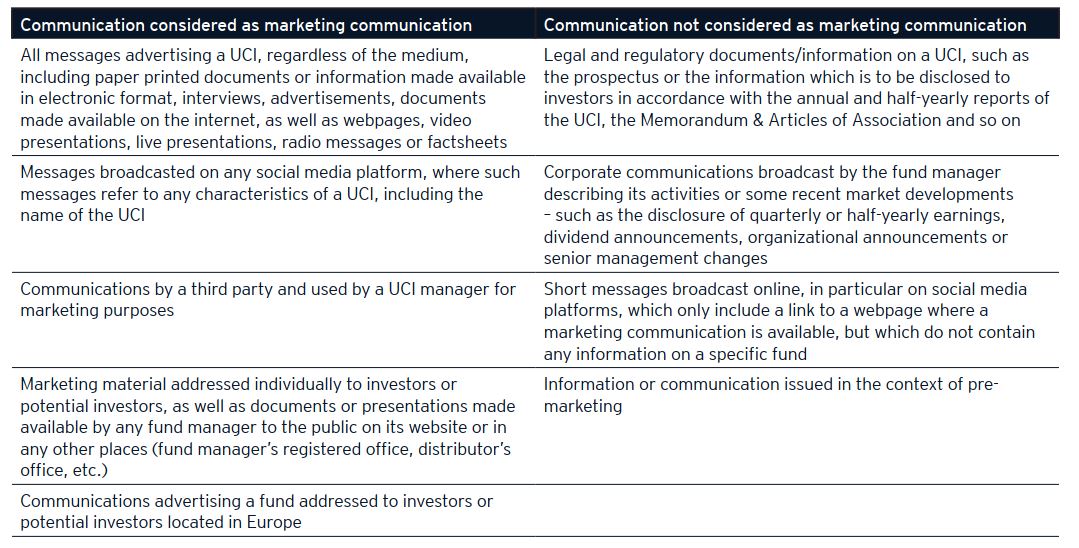Regarding the content of marketing communications, the key takeaways of the ESMA guidelines are the requirements to:
1 Clearly identify marketing communications
The identification of marketing communications should be prominent and, when the format allows, it should include the following disclaimer: “This is a marketing communication. Please refer to the prospectus of the UCI/Information document of the UCI and to the [KIID/KID] before making any final investment decisions.”
Any reference to a UCITS or an AIF in a marketing communication should only be published after the UCI’s approval by the national competent authority. Excessive cross-references to legal or regulatory provisions should be avoided unless this is appropriate.
2 Disclose risks and rewards in an equally prominent manner
Rewards should not be referred to without referring to risks in the same document. Risks should not be presented in footnotes or smaller characters but at the same level or immediately after rewards. Presentation in the form of a two-column table or in a list differentiating risks and rewards on a single page is considered as an acceptable practice.
3 Ensure all marketing communications are fair, clear and not misleading
IFMs should stick to a number of general rules, notably in relation to:
- The suitability of the marketing communication to the target investors or potential investors: excessively technical wording should not be used for UCIs open to retail investors
- The consistency with other documents (prospectus, offering document, KID/KIID, periodic reports, IFMs’ websites), in particular for indicators, simulations or figures relating to risks, rewards, costs or past and expected future performance
- The description of the features of the investment. The information should be up to date, proportionate but sufficient to understand the key elements of those features, without making excessive cross-references to the UCI’s legal and regulatory documents. It should clearly distinguish investment in the UCI from an investment in a given underlying asset and should include a brief description of the investment policy and the types of assets into which the UCI may invest. Any information on the use of leverage should include an explanation on related risks of potential increased losses or returns
- Specific terminology to be used to clearly distinguish index-tracking UCIs from actively managed UCIs. Active UCIs managed in reference to an index should provide information on the benchmark index and indicate the degree of freedom from the benchmark
- References to the national competent authorities. It is acceptable to mention visa/authorization but it should not be used as a sales argument
- Short marketing communications, such as messages on social media, which should provide links to the webpage where the information documents of the UCI are available
- Statements embedded in the communications which should be objective and verifiable, while overoptimistic or biased wordings are prohibited
- References to external documents and comparison with other funds
Information on risks and rewards should include at least the risks mentioned in the regulatory documents (prospectus, offering document, KID/KIID). When the UCI is marketed to retail investors, the illiquid nature of the investment, where relevant, should be clearly mentioned. Any representation of ranking should be based on similar UCIs in terms of investment policy and risk/reward profile. The relevant period and UCI’s risk classification must be indicated.
Information on costs should allow investors to understand their impact on their investment amount and expected returns. Exchange rate risk should be specified where any costs are paid in a currency other than the member state in which the target investors are residents.
Information on past performance should not be the main information of the marketing communication. Past performance should be based on historical data and mention the reference period of 10 years for UCIs preparing a KIID, five years for other UCIs or the whole life of the UCI where it has been offered for a shorter period. Any significant change affecting the past performance should be prominently disclosed. When cumulative performance is presented, the communication should also display the performance for each year. Currency risks and their impact on returns to investor should be mentioned.
Simulated performance should be limited to:
- A new share class of an existing UCI/compartment where the simulation is based on the performance of another share class with the same features
- A new feeder UCI where the simulation is based on the performance of the master UCI, provided that the feeder’s characteristics do not differ materially from those of the master and that no other assets are held by the feeder
When past performance is presented, a statement that past performance does not predict future returns should be included.
Information on expected future performance should be based on reasonable assumptions supported by objective data. It should be disclosed at the level of the UCI, not on an aggregate basis, on a time horizon which is consistent with the recommended investment horizon of the UCI. Different disclaimers should be included to highlight the limits of estimates, the impacts of market conditions, taxation and risks of loss. ETF’s marketing communications should indicate the regulated market where the ETF is traded and the expected future performance should be based on the ETF’s NAV.
Information on sustainability-related aspects should not outweigh the extent to which the investment strategy of the UCI integrates sustainability characteristics or objectives.
A link to regulatory disclosures required by the sustainable finance disclosure regulation should be provided and the marketing communication should indicate that a decision to invest in the UCI should consider all characteristics or objectives disclosed in the prospectus or the offering document.
While the Guidelines largely formalize existing market practices, they will create a level playing field for IFMs and they should also make marketing communications more comprehensible and transparent for investors.
1 Regulation (EU) 2019/1156 of 20 June 2019 on facilitating cross-border distribution of collective investment undertakings



